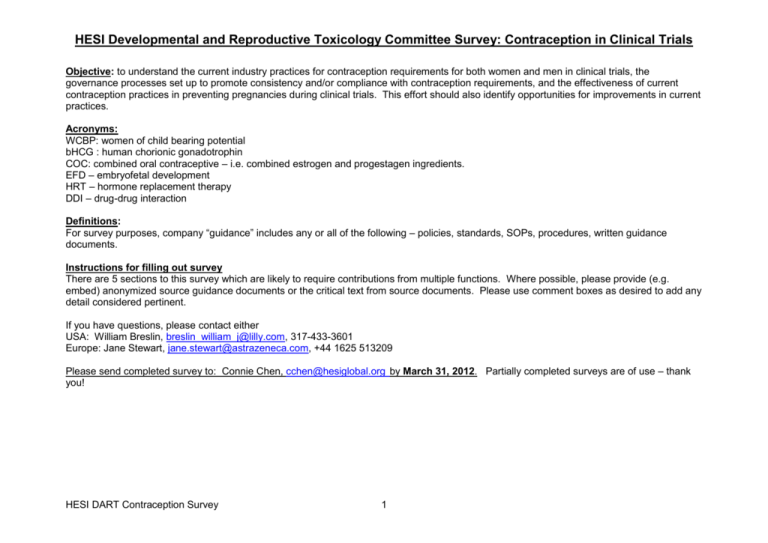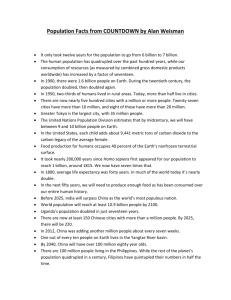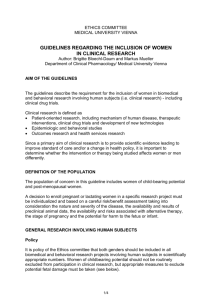HESI Developmental and Reproductive Toxicology Committee
advertisement

HESI Developmental and Reproductive Toxicology Committee Survey: Contraception in Clinical Trials Objective: to understand the current industry practices for contraception requirements for both women and men in clinical trials, the governance processes set up to promote consistency and/or compliance with contraception requirements, and the effectiveness of current contraception practices in preventing pregnancies during clinical trials. This effort should also identify opportunities for improvements in current practices. Acronyms: WCBP: women of child bearing potential bHCG : human chorionic gonadotrophin COC: combined oral contraceptive – i.e. combined estrogen and progestagen ingredients. EFD – embryofetal development HRT – hormone replacement therapy DDI – drug-drug interaction Definitions: For survey purposes, company “guidance” includes any or all of the following – policies, standards, SOPs, procedures, written guidance documents. Instructions for filling out survey There are 5 sections to this survey which are likely to require contributions from multiple functions. Where possible, please provide (e.g. embed) anonymized source guidance documents or the critical text from source documents. Please use comment boxes as desired to add any detail considered pertinent. If you have questions, please contact either USA: William Breslin, breslin_william_j@lilly.com, 317-433-3601 Europe: Jane Stewart, jane.stewart@astrazeneca.com, +44 1625 513209 Please send completed survey to: Connie Chen, cchen@hesiglobal.org by March 31, 2012. Partially completed surveys are of use – thank you! HESI DART Contraception Survey 1 HESI Developmental and Reproductive Toxicology Committee Survey: Contraception in Clinical Trials Company: CODENAME: A. Company guidance for contraception and/or barrier protection for male subjects with partners of childbearing potential. 1 2 3 4 5 6 7 Is there company guidance for contraception or barrier protection requirements for men in clinical trials? If contraception or barrier protection use is specified, how is the duration of post-trial contraception determined? Is double barrier protection ever required? Are 2 forms of highly effective contraception ever required? If so, under what circumstances. Are there company restrictions or guidance for enrolling men with pregnant partners? Do contraception and barrier protection requirements differ between small molecule and biologic drugs? Any other comments: Yes/No Please summarize key requirements and governance process Please describe. Yes/No, If yes, under what circumstances. Yes/No, If yes, under what circumstances. Yes/No. If yes, please describe. Yes/No. If yes, please describe. B. Company guidance on management of WCBP in clinical trials 1 Is there a company-wide definition of a WCBP? 2 Is there company guidance on birth control requirements for WCBP in clinical trials? If contraception or barrier protection use is specified, how is the duration of post-trial contraception determined? Is there company guidance that details the birth control methods considered acceptable for use? E.g., male condom, COCs, copper-banded IUD etc Do contraception requirements differ between small molecule and biologic drugs? 3 4 5 HESI DART Contraception Survey No / Yes Please provide WCBP definition No/ Yes, If yes, please describe the basic requirements and governance process. Please describe No/ Yes Please provide list of recommended methods Yes/No. If yes, please describe. 2 HESI Developmental and Reproductive Toxicology Committee Survey: Contraception in Clinical Trials 6 7 8 Pretrial enrollment procedures: a) Does policy require pregnancy testing before enrollment of all WCBP on clinical trials? a) No/Yes b) If yes, what are the technical detail regarding timing and type of pregnancy testing (e.g. urinary versus serum bHCG, time before first dose) are specified? b) Please provide technical details c) Are there exceptions regards requirements for pretrial pregnancy testing? c) Describe exceptions d) Is confirmation of a menstrual period required prior to trial entry? d) Yes/No e) What other conditions are specified pre-trial to ensure WCBP are not pregnant? e) Provide other criteria f ) What information is given to WCBP on the acceptable birth control methods for the clinical trial? During trial & post trial procedures a) Is pregnancy testing typically or rarely required during dosing in a clinical trial? f) Provide example of the typical information b) Is ongoing birth control compliance monitored? b) Yes/No rarely. If rarely, describe circumstances. c) At checks in a clinical trial, are WCBP routinely asked to reconfirm compliance regards birth control requirements for that trial? c) Yes/No, If yes, please describe monitoring procedure. d) What pregnancy testing is typically required after cessation of dosing? d) Yes/No, Describe a) Yes/No typically. Any other comments: HESI DART Contraception Survey 3 HESI Developmental and Reproductive Toxicology Committee Survey: Contraception in Clinical Trials C) 1 2 i) 3 ii) 4 iii) 5 iv) 6 v) 7 vi) 8 Influence of Animal Data on birth control requirements on clinical trials Is there policy / guidance on what developmental toxicity animal data should be available before WCBP are enrolled in clinical trials? When / if proceeding into WCBP clinical trials without EFD studies in 2 species, what difference (if any) does that make to birth control or pregnancy testing on the trial? For WCBP on trials, when animal data illustrates potential for fetal harm at clinical exposures, what difference (if any) does that make to birth control or pregnancy testing on the trial? For men on trials, when animal data illustrates potential for fetal harm at clinical exposures, what difference (if any) does that make to birth control requirements on the trial? For men on trials, when animal data illustrates potential for testicular toxicity at clinical exposures, what difference does that make to informed consent and birth control requirements on the trial? When the embryo/fetal and male and female fertility data indicate no risk, does this information impact contraception requirements for men or WCBP? Does the margin of safety for embryo/fetal toxicity impact contraception requirements? Other comments: No / Yes If Yes, please describe default and any key exceptions to that default. If yes, is the guidance different for small molecules vs. biologics? Yes/No. If yes, please explain. Yes/No. If yes, please explain. D) Drug-Drug Interaction work to support hormonal contraceptives / HRT 1 2 Is there company guidance on the DDI testing required prior to allowing use of systemic hormonal contraceptives? What default testing for DDI is required? HESI DART Contraception Survey No / Yes Please summarize key aspects Please describe the in vitro/in vivo test cascade 4 HESI Developmental and Reproductive Toxicology Committee Survey: Contraception in Clinical Trials 3 4 5 Would a final submission package generally include a DDI study with ethinylestradiol/COC? If not, what would trigger need for a specific DDI study with ethinylestradiol or a COC? What criteria are used to determine if a DDI signal is of sufficient magnitude to be of concern regards either COC efficacy ( decreased exposure to estrogen component) or COC / HRT safety (e.g. increased exposure to estrogen component) Any other comments: Yes / No No, describe trigger Describe criteria for decreased exposure: Describe criteria for increased exposure: E) Reporting and Review of Pregnancies in Phase I – Phase III Clinical Trials 1 Is there company guidance on reporting and follow up on inadvertent pregnancy drug exposure in WCBP in clinical trials? What is the reporting mechanism? No Yes – provide key aspects of guidance & reporting mechanism 2 In clinical trials where the men were requested to use contraception, is there company guidance on reporting and follow up of pregnancies in WCBP partners? What is the reporting mechanism? Yes/No If yes – provide key aspects of guidance & reporting mechanism 3 Reported pregnancies What information is gathered about the (failed) birth control method? What other information is typically gathered about the exposed pregnant patient (e.g. primagravida etc) Review of Pregnancy rates in trials including WCBP a) Is there a routine review of reported pregnancy rates at the end of trials? 4 b) Is there a review of reported pregnancy rates at HESI DART Contraception Survey a) Yes/No b) Yes/No 5 HESI Developmental and Reproductive Toxicology Committee Survey: Contraception in Clinical Trials the end of trials with test agents considered likely to cause fetal harm? 5 c) What (if any) oversight of the pregnancy rates across multiple trials is undertaken (egg internal ethical review board on an annual basis?) c) Describe d) Is there a review of pregnancy rates with drugs that have a DDI with hormonal contraceptives? d) Yes/No e) Are pregnancy rates summarized by geographical area or country to understand the cultural impact on contraception practices and effectiveness? e) Yes/No. If yes, did this review prove informative; explain. Any other comments: HESI DART Contraception Survey 6




